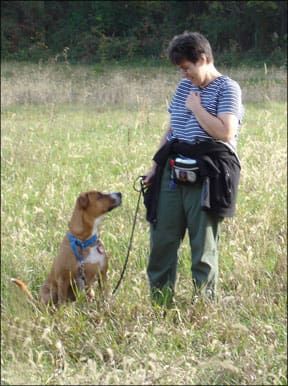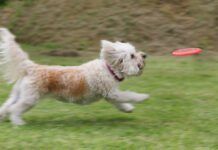That loud buzz you hear is the sound of the dog behavior and training community discussing a controversial new approach to modifying aggressive behavior in dogs. The developers of “Constructional Aggression Treatment” (CAT) claim that the shaping-based operant protocol produces stronger and much faster results than the classical counter-conditioning process widely used by training and behavior professionals today.
CAT was devised and tested by Dr. Jesús Rosales-Ruiz, a behavior analyst and associate professor of behavior analysis at the University of North Texas, and Kellie Snider, a board-certified associate behavior analyst. Snider completed her MS in Behavior Analysis at UNT in 2007 with Dr. Rosales-Ruiz as her graduate research advisor and the CAT procedure as the topic of her thesis research.
Canine behavior experts frequently use classical conditioning techniques (including counter-conditioning) to help change how dogs feel about and respond to the stimuli that triggers their aggressive behavior. In other words, classical counter-conditioning changes the dog’s emotions in order to change his behavior. In contrast, CAT utilizes “operant conditioning,” where the goal is changing the dog’s behavior in a way that will likely produce a subsequent emotional change.
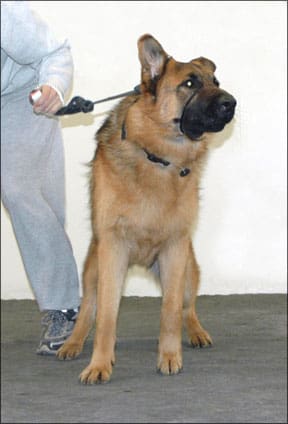
288
In order to best explain how this novel technique works, allow me to back up and discuss some behavioral theories that explain both the development of canine aggression as well as the techniques that are conventionally used to change the dog’s response to stressful stimuli.
The genesis of aggression
Conventional thinking is that aggression is the behavioral result of an emotional response (fear, anger, frustration, etc.) that has been classically conditioned due to an association between two stimuli (events).
For example:
• A small child hugs a puppy too tightly, hurting the puppy. The puppy associates pain with small children, and becomes fearful and aggressive toward small children as a result.
• A large, aggressive dog attacks a smaller, unassertive dog, causing multiple injuries. The small dog associates large dogs with attack and pain and becomes fearful and aggressive toward large dogs.
• Teenagers tease a dog in a yard behind a fence. The dog becomes aroused, angry, and aggressive toward teens.
So, the thinking goes, the best approach to modifying a classically conditioned response is with counter-conditioning – a subset of classical conditioning in which you change the dog’s emotional response. You do this by pairing the fear- or anger-causing stimulus with something that creates a happier response, thus giving the stimulus a new, positive association.
Food is commonly used to counter-condition, because it’s hard to eat yummy treats and be significantly angry or afraid at the same time. Also, food is a “primary reinforcer”; our dogs are hardwired to like food; they don’t have to learn that it’s valuable to them.
You can use other things to change associations in place of, or in addition to, food. With humans, money, jewelry, and other conditioned reinforcers (items with learned value) can be used to create and change associations. Think of the enamored suitor, wooing the object of his affections, plying her with all sorts of goodies to create a positive association while she plays hard to get. Dogs aren’t much impressed with diamonds and Cadillacs, but a rousing game of tug or fetch-the-ball can give a worried dog a positive association with a previously aversive stimulus.
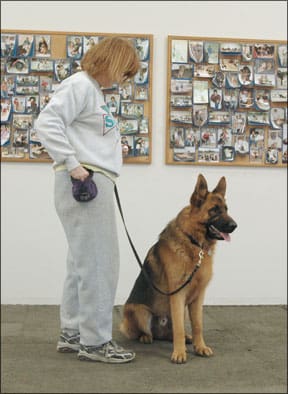
288
A counter-conditioning procedure goes like this:
• Present scary stimulus (say, a small child) at a distance great enough that the dog is worried (“Uh-oh, there’s a child!”) but not so worried that he goes into a barking, lunging frenzy. This is called the “sub-threshold” distance.
• The instant the dog sees the child, start feeding tiny bits of something very yummy, such as canned or boiled chicken.
• Keep feeding until the child is out of sight, then stop feeding.
• Repeat this process until the appearance of the child at this distance consistently causes the dog to look joyfully at you in anticipation of chicken. This is called the conditioned emotional response (CER), or the “Where’s my chicken?” look.
• Now increase the intensity of the stimulus and repeat the process. With a child, you might increase intensity by bringing the child a little closer, or by staying at the original distance and having two children appear, or one child running, skipping, or singing, or . . .
Eventually, due to the change in the dog’s emotional response to the presence of a child, then to the presence of children, the dog’s behavior changes. He comes to like children, so he’s no longer aggressive toward them.
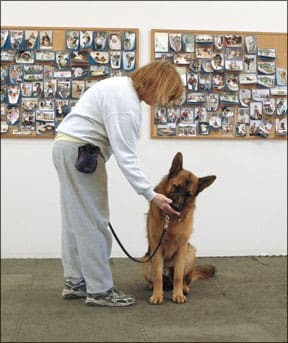
288
How CAT is different
CAT’s founders acknowledge that aggression may be, initially, an emotional response, based in classical conditioning. However, they assert that operant conditioning quickly begins to play a much larger role than it’s often given credit for. They suggest the dog quickly learns that growling, barking, lunging, and snapping are highly successful strategies for making the threat leave, and so the behavior is negatively reinforced (the dog’s behavior makes a bad thing go away).
By definition, behavior that is reinforced continues or increases. Snider and Rosales-Ruiz posit that if you prevent the dog from receiving reinforcement for the unwanted behavior (aggression) and reinforce his desired behavior (friendly, affiliative actions), his behavior will change. When the behavior changes, the emotion that triggers the aggression will change as well.
CAT used for
dog-dog aggression
Here is how the CAT procedure would be used to modify the behavior of a dog who shows aggression toward other dogs:
The subject dog (the one with the aggressive behavior) is set up in an area where the trigger stimulus can be presented at a distance that does not trigger a big response from the subject dog (this is called “sub-threshold”). In this case, the trigger stimulus is another dog; note that people or objects can be the triggering stimuli in other cases.
Ideally, the environment where the procedure is carried out is the same or similar to the one in which the undesirable behavior normally occurs. This reduces the amount of future generalization required. The owner – not a trainer – holds the dog’s leash, which also keeps the stimulus picture as close to reality as possible and reduces the amount of generalization needed.
Other than restraining the dog, the owner does nothing else in terms of training – no clicking, no treating. The behavior of the stimulus dog becomes the sole reinforcer for the subject dog’s behavior.
The stimulus dog (sometimes called decoy or trigger dog) and handler approach the subject dog until sub-threshold signs of stress are noted by observers. This is the “threshold.” The handler and decoy dog stop and wait for any decrease in the subject dog’s stress behavior, at which point the decoy and handler immediately turn and walk away, reinforcing the subject dog’s more appropriate (less stressed) behavior.
If the subject dog barks, lunges, or offers other aggressive behavior as the decoy dog leaves, the handler and decoy immediately return to baseline to again wait for decreased signs of stress. Then they again attempt to leave. This is repeated until the subject dog no longer offers escalated stress behavior when the stimulus dog and handler attempt to leave. When this happens, they retreat to a greater distance to give the subject dog an opportunity to relax.
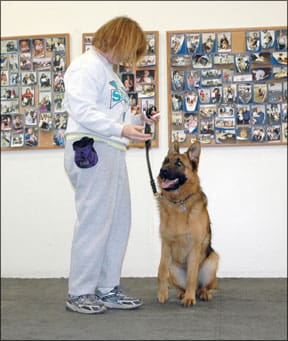
288
An assistant marks the location where the threshold behavior occured, and the stimulus dog and handler return to this mark after a 15-second “cool-down” period. This return-and-leave process continues until the subject dog no longer shows signs of stress at baseline, at which point the handler brings the stimulus dog closer to the subject by a distance predetermined by the trainer – less if the dog is likely to be easily triggered, more if the dog is perceived as able to handle a larger increment of decreased distance.
Eventually it should be possible for the stimulus dog to approach with no aggressive reaction from the subject. In fact, in a successful procedure the subject dog begins to genuinely and happily invite the stimulus dog closer for more interaction. This point in the procedure is called switchover.
After switchover, the stimulus dog and handler continue to approach the subject dog in small increments until the two dogs can actually engage in friendly behavior with each other. The researchers labeled this part of the process interaction.
Why does it work?
Remember, many dogs who behave aggressively toward other dogs do so as a result of learning that their barking, growling fit results in the other dog going away. Because that behavior has been successful in the past, it’s been reinforced, and the behavior has continued or increased.
In contrast, in a CAT procedure, the subject dog is presented with a different reinforcement scenario. The behavior that worked so well before – barking and lunging – no longer works. Instead of making the other dog go away, it actually makes her stay close or come back! A new behavior – acting calm – now makes the “bad approaching dog” go away. So, in theory, the subject dog learns to offer calm, relaxed behaviors to make the other dog go away.
Eventually the subject dog becomes calm and relaxed because he no longer needs to act aggressively to make the other dog go away. Lo and behold, once the subject dog becomes calm and relaxed about the other dog approaching, he actually gets happy about having the other dog approach; the change in his emotional response follows the change in his behavioral response.
Rosales-Ruiz and Snider have worked with or received reports of almost 100 dogs using the CAT procedure, and the results, they say, are overwhelmingly encouraging. Dogs with a lifetime history of aggression toward other dogs have become completely canine-social-appropriate. Dogs with a long record of aggression toward humans have become safe and friendly. Not every single one, of course, but the majority of dogs have done mind-bogglingly well with the procedure.
Things to consider
The dog training and behavior community has not yet embraced the procedure with open paws. As striking as the reported results may seem, there are some significant potential obstacles to the widespread use of CAT. Trainers who might consider using this procedure professionally are struggling with some of the challenges:
– The sessions can be intensively time-consuming.
Individual CAT sessions may run from as little as one hour to as much as eight, and require a number of helpers. When possible, the founders recommend sticking with it at least until you see switch-over (the point at which the subject dog’s behavior changes to actually offering distance-decreasing behavior such as soft body wags, ears back, soft and/or squinty eyes) and preferably all the way through interaction. Snider suggests setting aside three full days to work with an individual dog and owner.
Snider points out, however, that classical conditioning and desensitization (CC&D) is also time-consuming. Many owners practice CC&D on their own for months or years with less effect.
– It’s costly. Good training and behavior professionals may charge anywhere from $50 to hundreds of dollars per hour for their time. Three full days, eight hours per day, at hundreds of dollars per hour equals a lot of money spent in a short period of time. Of course, if it works, it may be worth almost any amount to an owner, and, over time, it may not be significantly more costly than ongoing CC&D with a trainer.
– It’s staff-intensive. Done well, the procedure requires at least several humans – the owner, the trainer, the handlers of several stimulus dogs (or presenters of whatever the trigger stimulus may be), and perhaps a person to videotape the procedure for later review. This can also add to the cost, if assistants are paid.
– It can be stressful to the subject dog. In some cases where the procedure has failed, the subject dog has continued to practice the bark/lunge strategy that’s been successful for him in the past, rather than offering – and switching over to – calm, relaxed behavior. Some trainers trying the procedure have pulled the plug early in the process rather than continue to subject the dog to the level of stress apparent as the old strategy failed to work. Other trainers have persisted for long periods of time (hours) before either giving up or ultimately achieving success.
On these counts, in CAT’s defense, Snider says, “Even with those dogs that did not completely switch over because the trainers didn’t take it that far, we have almost universally seen dramatic improvement. Trainers who are new to this procedure may need more practice and guidance before they learn to how to keep the dog below threshold by adjusting the environment in some way. If you don’t work below threshold, it’s not really CAT . . . and it’s unlikely to work as well. It’s too difficult for dogs to produce desirable behaviors when they are over threshold, and this is no different from CC&D.”
– It can be stressful to the stimulus dog. The stimulus dog will be asked to repeatedly approach a dog who is sending very clear “Don’t approach!” signals and appears to be more than willing to back the signals up. This can take a toll on the good nature of the neutral/friendly dogs being asked to play decoy. In fairness, the same can be said of dogs used as decoys in conventional CC&D sessions.
– Even when all goes according to plan, trainers may be reluctant to complete the final piece of the process – interaction – and rightly so. Misjudgment on the part of the trainer can result in injury to the stimulus dog (or trigger person/s). Again, to be fair, this is a risk whenever working with aggressive dogs.
– It may not be positive. One definition of “positive training” holds the position that positive trainers use negative reinforcement only as a last resort, after positive reinforcement and negative punishment have failed. Negative reinforcement, by definition, requires the presentation of something at least mildly aversive to the dog, and sometimes the presenting stimulus is significantly aversive.
Snider and Rosales-Ruiz offer CAT as a first approach, not after exhausting what are traditionally considered more positive methods. In fact, they say the less the dog has been worked with using other methods, the easier and more successful CAT is likely to be. In response to these points, Snider says, that in her opinion, CAT can be more positive than desensitization. “With desensitization, often trainers move closer if the dog gets calm (which constitutes punishment of calm behaviors) and move away when the dog is stressed (reinforcement of stressed behaviors). That’s one reason it takes longer!
“Also, sometimes the presenting stimulus is significantly aversive in CC&D programs, too. You can’t train an animal to accept something that is not there, and prior to treatment, having it there is stressful. The best you can do is present it at low intensities, which is an integral part of CAT just as it is of CC&D.”
Snider also points out that even positive reinforcement can be used in ways that produce problematic behaviors. “As Dr. Rosales-Ruiz has said, it is not about the name of the procedure, it’s about the emotionality produced by the procedure. Properly done, CAT produces happy, friendly dogs while working hard to remain errorless – which means keeping the intensity of the stimulus low enough that it is not overwhelming to the learner.”
Pat’s CAT journal, day 1
My own mind is still not made up about CAT. I have done the procedure once (I’ll describe this in detail below) with a dog I know well, owned and handled by Certified Pet Dog Trainer Jolanta Benal, of Brooklyn, New York. Jolanta is a friend and trainer for whom I have much trust and respect.
Going in, we were both cautious and somewhat skeptical, albeit hopeful, and we were both ready to stop the procedure at any time if either of us was uncomfortable with what we were seeing. I was happier with the results than I had dared hope to be, and will offer it on a limited basis to clients who I think can make the necessary commitment and whose dogs I feel are appropriate candidates.
Jolanta and I spent three days trying out the CAT procedure. Our subject dog was Juniper, Benal’s six-year-old neutered Pit Bull-mix. Juni has been dog reactive/aggressive since puppyhood, and several of his littermates also have aggression problems. At least two have been euthanized for aggression.
Juni is extremely friendly with humans, in large part due to growing up in Brooklyn, where Jolanta made it a point to socialize him well with a wide variety of humans. Unfortunately, living in NYC, anywhere he goes, Juni encounters other dogs – and the socialization didn’t work with those, despite Jolanta’s best efforts. Juni does have a circle of canine friends he can play with, including 13-year-old Cattle Dog-mix Izzy, with whom he lives.
Jolanta has done a considerable amount of work with Juni. They attended our Reactive Rover Camp and did well, easily progressing to parallel walking with other dogs by the end of the third and final day of camp. Juni could control himself, but was not relaxed and friendly with the other dogs, and it didn’t carry over to the urban home environment.

288
Back in NYC, Jolanta found it pretty impossible to keep Juni sub-threshold – one of the challenges of ongoing counter-conditioning work with a reactive dog. Jolanta does a good job of keeping Juni focused on treats when necessary, and he has a very effective “run away” escape behavior. (As described by Patricia McConnell in her excellent booklet, Feisty Fido, a reactive dog is taught “Run away!” as a fun game, whereby the owner walks with the dog by her side, and suddenly says “Run away!” or some other cue in an excited tone of voice, then quickly turns and runs playfully in the other direction. Each time, at variable distances, the owner reinforces the fun aspect of the game with yummy treats or with a quick game of tug, until “Run away!” takes on a positive classical association. As a result, when the reactive dog and owner are out walking and a dog appears unexpectedly, the owner can use the “Run away!” cue to get her dog to happily turn and run with her, away from the other dog, rather than having a super-threshold eruption.)
We started the CAT process on Monday in early March, in the Peaceable Paws training center. Not ideal in terms of “recreating the actual environment,” (our farm is nothing like NYC!) but we wanted to maximize potential for some success, and it’s impossible to control intensity of stimulus in the Big Apple.
A dozen trainers attended one or more days of the three-day program to learn and assist. Our first stimulus dog was Amber, a small, mature female Rhodesian Ridgeback who belongs to Peaceable Paws apprentice Susan Sarubin.
Susan presented Amber at a distance of about 75 feet from Juni (one end of the training room). Juni immediately erupted, barking and lunging, hackles up. Jolanta had warned us that his threshold distance is “line of sight,” barring any efforts to divert his behavior. Juni confirmed the veracity of her warning. So “just inside the door” was our baseline.
It took several repetitions before Amber was able to enter the room without Juni erupting. Even then, Juni was still pretty tense. We did several more repetitions with Juni erupting when Amber and Susan turned to leave; they had to turn back toward Juni and return to the baseline mark. We looked for, and accepted, very small signs of relaxation from Juni as the trigger to make the stimulus dog (Amber) go away – the flick of an ear, blinking, a slight lowering of the head. When we got to the spot where no eruption took place, we began moving the marker closer, one foot at a time. It seemed like it took an eternity, but was actually no more than 10 minutes.
We worked with Amber as the only stimulus dog on the first day. At about 35 feet we began getting attention-soliciting affiliative behavior from Juni: soft tail wagging, relaxed body, ears back, squinty eyes. We continued to decrease the distance, and at about 10 feet (near the end of the session) we lost the soft behavior; Juni again began growling, barking, and even added a snarl (lips curled up) – a behavior we hadn’t seen before. We continued to repeat presentations at that distance until Juni relaxed again, although not to the point of the soft, waggy behavior we had seen previously.
We worked a total of three hours on that first day, with two breaks. In debriefing the session, Jolanta and I agreed that if we encountered a “stuck” spot again we would back up the stopping point to a place where Juni offered stress behavior but didn’t go over threshold, and work there until he again showed soft, friendly behaviors. Later conversation with Dr. Rosales-Ruiz confirmed that this would have been an appropriate step. As it turned out, we didn’t need it.
CAT, day 2
On the second day, we introduced Willow, a spayed Shepherd/Collie-mix owned by DC-area Certified Pet Dog Trainer Pen Brown. Juni immediately erupted upon presentation of Willow at 75 feet. This was disappointing; we were hoping to see more of a change in Juni’s behavior upon initial presentation. We were, however, able to progress more quickly this time; Juni’s barking stopped after just a few repetitions, and at the first-hour break we had moved the marker to about 35 feet and were getting soft, solicitous responses from Juni.
We switched dogs after the first break, introducing Bonnie, my three-year-old Scottie-mix. Snider and Rosales-Ruiz would probably have suggested proceeding to interaction with one dog before switching, but none of us were confident enough with the procedure to do this. In addition, Jolanta wanted to work on generalizing to as many different dogs as possible, knowing that she would face a constantly changing cast of canine characters back home in New York.
Juni had met Bonnie at a Reactive Rover Camp many months prior, parallel walking with her without incident on the last day of camp. Now, with CAT, there was some barking on the initial presentation of Bonnie at 75 feet, but it was less intense than with Willow, and we progressed forward rapidly. Between 40 feet and 10 feet we got very playful behavior from Juni: play bows, full body wags, and several “Don’t go away!” vocalizations on several occasions when Bonnie and I turned to leave. (This is a significantly different vocalization than Juni’s “Go away!” bark,)
At the end of that second day, we were parallel-walking Bonnie and Juni around the training center, about four feet apart. Juni was relaxed, and even made several play-bounce moves toward Bonnie – a behavior he had never shown toward her at Reactive Rover Camp. We chose not to let them play, as there is a significant disparity in size and we felt Juni would be too rough for Bonnie, even if he maintained his friendly demeanor.
CAT, day 3
On the third day we changed our location, transporting all of our dogs to a local, dog-friendly outlet mall – the closest approximation to a city environment we could come up with in rural Fairplay, Maryland. We started with Willow again, positioning Juni about 50 feet from the corner around which Willow would appear. There were no eruptions at all on day three. None! Not even when Pen invited Willow to leap in the air. (Historically, bouncy behavior was a guaranteed trigger for Juni to erupt.) We quickly progressed from 50 feet to about 10 feet, and then walked the two dogs together in the mall parking lot, sometimes as close as three to four feet apart. Juni was relaxed and unconcerned. We were not just pleasantly surprised; we were ecstatic.
We returned to the store front area, put Willow away and brought out Missy, my eight-year-old spayed Australian Shepherd. We were eager to see what would happen with a new dog. Juni had never seen Missy, and Missy is naturally bouncy – a potential double whammy. Again, no eruptions, rapid closure to about six feet, then walking together at close distance. We did get one small growl and a little tension when Missy was about 15 feet from Juni while we were doing the initial approaches, but he was immediately relaxed again on the next approach.
We brought Willow back, and worked with all three dogs together, then introduced Lucy, my Cardigan Corgi, and finally added Bonnie to the mix. We finished the morning after 90 minutes with all five dogs walking around one end of the mall, passing in close quarters, following Juni, approaching head-on, and appearing unexpectedly around corners. Juni was completely relaxed, as were the rest of the dogs. The humans, on the other hand, were all pretty excited. After close to eight hours of successful CAT work, the true test was yet to come. We headed back to our respective homes, waiting to hear from Jolanta on how Juni would do back home in his own ’hood.
Dog in CAT city
The first report was promising. Jolanta called it in from her cell phone before she even got home. Juni saw a dog through the car window and did nothing! Prior to all the CAT work, this would have elicited a full-scale aroused eruption.
Jolanta continues to send glowing reports about Juni. He’s not letter-perfect, but is behaving far better around other dogs than he ever did in his pre-CAT experience. According to Jolanta, they have encountered more than 100 dogs per week since their return to Brooklyn, and experienced only six full-scale “explosions.” In 30 of the encounters, Juni growled or barked or exhibited some degree of tension. In almost every “tense” episode, Juni calmed himself quickly without intervention from Jolanta. Most happily, Jolanta says, “More than 60 encounters with approximately 70 dogs were characterized by responses ranging from complete indifference/nonchalance to active interest, to mild alertness that didn’t shade into tension.”
When asked how many of these incidents she estimates would have previously resulted in escalation to eruption, she answered, “Most of the ‘tense’ encounters would likely be explosions of one degree or another. I would not have seen any nonchalance though I would have had a lot of success distracting him with food.”
I believe the CAT program has significant value for certain dogs; it could mean a much brighter future for a lot of dogs who are currently under house arrest and strict management programs. I’ll be looking for additional appropriate applications for CAT. I have another client who wants to try CAT on her dog, and I fully intend to use it with Dubhy, our dog-reactive Scottie, the next time my husband and I want to introduce a new dog to our pack, if not sooner.
Pat Miller, CPDT, is Whole Dog Journal’s Training Editor. Miller lives in Hagerstown, Maryland, site of her Peaceable Paws training center. Pat is also author of The Power of Positive Dog Training; Positive Perspectives: Love Your Dog, Train Your Dog; and Positive Perspectives II: Know Your Dog, Train Your Dog. See “Resources,” page 24.



